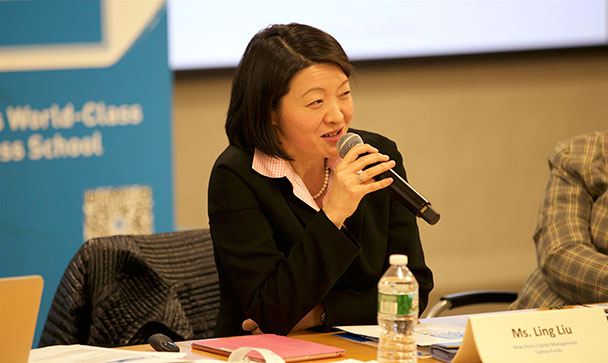Liu Ling, a managing director at New China Capital Management, the investment manager for Cathay Funds, told a CKGSB Knowledge Series event that China’s stock-market gyrations are the growing pains of a “healthy and solid” economy, highlighted by China’s middle class overtaking America’s to become the biggest in the world.
During the February 22 session, “Investment Strategy for China’s Volatile Markets,” Ms. Liu, a former Vice President in Morgan Stanley’s investment banking division in Hong Kong and New York, also said investors’ reaction to the market turmoil is evidence of the “inverse relationship” between consumer spending and financial turbulence in China.

Liu Ling of New China Capital Management addresses a
CKGSB Knowledge Series audience in New York
“The whole doomsday scenario, that China’s going to stop growing, China’s going to go into recession, is not a very realistic one,” she told the audience at CKGSB’s New York office. “There’s growing pains in China. It definitely is not growing at 7 percent – it doesn’t need to be.
“There’s a very vibrant economy behind it. It’s still a very interesting and rewarding place to make investments,” she said. “The growth is all in the private sector where it caters to consumers and services.”
Transforming society
The Knowledge Series session allowed Ms. Liu to share her expertise on investment strategies in China’s volatile markets. Knowledge Series events aim to disseminate advanced knowledge and perspectives related to China and promote in-depth dialogue in Chinese, Asian and global academic and business circles. The events are part of CKGSB’s mission to drive economic development and social progress through interaction with communities of high-level academics and senior business executives, becoming a catalyst of positive social transformation and an advocate of new business culture.
The explosive growth of China’s middle class saw it reach 109 million last year, overtaking the US’s for the first time. Ms. Liu defined middle class as those with an annual income ranging from 60,000 RMB to 229,000 RMB, or $9,000 to $34,000.
Meanwhile, wealth per adult in China has quadrupled to about $22,500 since 2000, according to a Credit Suisse report. The country now accounts for a fifth of the world’s population, while holding about 10 percent of global wealth.
Amid the changing of the guard, joining China’s previous achievements in eclipsing the US as the world’s largest automotive market, trading nation and importer of crude oil, China’s economy grew 6.9 percent in the first three quarters of 2015 – a six-year-low. That is “a slower, but arguably healthier, rate as the government strives to rebalance the economy toward a consumption-driven model,” and away from an over-reliance on exports and investment, Ms. Liu said.
Notwithstanding the volatile stock market movements and “weak” economic data that have spurred fears about the economy, it is a mistake to try to apply American views of volatility and economic health to understand the Chinese markets, Mr. Liu said. “It really does not reflect the underlying [Chinese] economy,” she said.

The Knowledge Series session, “Investment Strategy for China’s Volatile Markets,” allowed Ms. Liu to share her expertise on investment strategies in China’s volatile markets. Her presentation highlighted the Asian nation’s latest eclipsing of a mark previously held by the US: China’s middle class recently overtook America’s to become the biggest in the world.
Retail investors
For one thing, 80 percent of participants in the Asia market are retail investors, while in the US institutional investors dominate the playing field. “They trade [in China] purely on momentum,” Ms. Liu said. “They all want to make a quick return on it. In China, everybody is a stock picker.”
Secondly, Chinese stock investors manage their money through an inverse relationship with the market’s ups and downs. “When the market is down, Chinese take money out of the market,” Ms. Liu said. “They still need to either invest it or spend it.”
In a wild ride that globally surprised investors, China’s stock market surged more than 150 percent in 12 months before plunging last summer. “Retail investors recognized that the market was over-heated but nevertheless were lured by the quick, outsized return potential – the 151 percent gain was one of the world’s best returns in the first half of 2015,” Ms. Liu said.
The market eventually dived, a key factor being valuations becoming over-stretched. At the market’s height, the Shanghai “A” Share Composite Index traded at more than a 70 times average price to earnings ratio.
Household consumption
Nevertheless, research Ms. Liu shared from CEIC Data and CITIC Securities showed that the skid had limited impact on household consumption. Even at its lowest point in August, the Shanghai “A” Share Composite Index still traded 32.6 percent higher than a year earlier.
Moreover, for the typical Chinese household, stock market participation represented just 8.8 percent of total investment activity. Wealth management products represented 8 percent, pensions 5 percent and mutual funds 4 percent. Bank savings accounts represented 73 percent of household investment.
During the market upswing, purchases of big-ticket items such as cars were negatively affected as consumers put off buying in hope for a quick return from investing in stocks, Ms. Liu said.
For the future, consumption and the service sector continue to lead the growth at 7.1 percent and 8.4 percent respectively. Consumption made up 58.4 percent of GDP by the end of Q3 2015.
Although “wealth is coming down, it needs to be managed,” Ms. Liu said. “It isn’t necessarily a bad thing that it’s not going crazy. China is still the factory of the world, but they want to move up the value chain.” On that note, General Motors, the largest US automaker by sales, this year plans to start selling the Buick Envision, a sport utility vehicle made in Shandong province, to the US. GM thus will become the first major automaker to sell Chinese-made cars in the US. BMW is also considering selling its cars made in China abroad.
Cathay Funds, the investment vehicle which Ms. Liu helps New China Capital manage, includes a series of China-focused private equity funds with total assets under management of $800 million. It provides growth capital to middle-market companies in the fast-growing private sectors of the Chinese economy. As a member of the company’s Investment Committee, Mr. Liu is primarily responsible for the implementation of exit strategies and evaluation and execution of new investment opportunities.
About CKGSB Knowledge Series
CKGSB’s Knowledge Series continues February 29 with “Entrepreneurial Trends in China’s Mobile Advertising – A Returnee’s Perspective,” with entrepreneur and Big Data marketing expert Alan Yan. On tap for March 1 is “Women Ascending: From Base Camp to CEO Summit, Tools for the Climb,” held in partnership with the Hong Kong Association of New York, with CKGSB Americas Senior Director Mary Wadsworth Darby moderating a panel of highly-placed women executives. On March 16, in a program titled “Business Confidence Index – How Is It Constructed and How Can It Be Used?” CKGSB Professor Li Wei will discuss his Business Confidence Index that measures business sentiment of Chinese executives about China’s macro-economic environment.
Knowledge Series memberships are available for young professionals, VIPs and corporations. For information, please contact Julie Zhu at juliezhu@ckgsb.edu.cn or +1-646-627-7729.